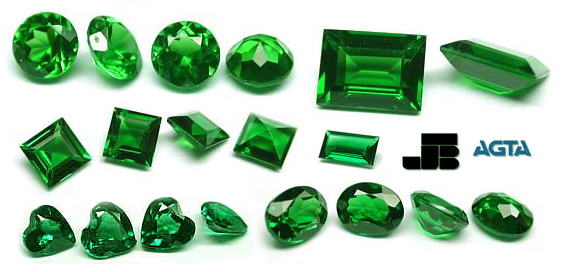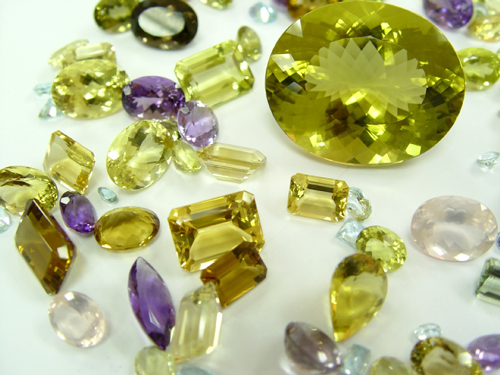
Jewellery is a form of personal adornment, manifesting itself as necklaces, rings, brooches, earrings and bracelets. Jewellery may be made from any material, usually gemstones, precious metals or shells. Factors affecting the choice of materials include cultural differences and the availability of the materials. Jewellery may be appreciated because of its material properties, its patterns or for meaningful symbols. Jewellery differs from other items of personal adornment in that it has no other purpose than to look appealing. Items such as belts and handbags are considered to be accessories rather than jewellery.
The word jewellery is derived from the word jewel, which was Anglicised from the Old French "jouel" circa the 13th century. Further tracing leads back to the Latin word "jocale", meaning plaything. Jewellery is one of the oldest forms of body adornment; recently-found 100,000-year-old beads made from Nassarius shells are thought to be the oldest known jewelery .
Jewellery is sometimes regarded as a way of showing wealth and might also possess some minimal functionality, such as holding a garment together or keeping hair in place. It has from very early times been regarded as a form of personal adornment. The first pieces of jewellery were made from natural materials, such as bone, animal teeth, shell, wood and carved stone. Some jewellery throughout the ages may have specifically been as an indication of a social group. More exotic jewellery is often for wealthier people, with its rarity increasing its value. Due to its personal nature and its indication of social class, some cultures established traditions of burying the dead with their jewellery.
Jewellery has been made to adorn nearly every body part, from hairpins to toe rings and many more types of jewellery. While traditional jewellery is usually made with gemstones and precious metals, such as silver or gold, there is also a growing demand for art jewellery where design and creativity is prized above material value. In addition, there is the less costly costume jewellery, made from lower value materials and often mass-produced. Other variations include wire sculpture(wrap) jewellery, using anything from base metal wire with rock tumbled stone to precious metals and precious gemstones.
Form and function

Jewelery has been used for a number of reasons:
- Currency, wealth display and storage,
- Functional use (such as clasps, pins and buckles)
- Symbolism (to show membership or status)
- Protection (in the form of amulets and magical wards) .
- Artistic display
Most cultures have at some point had a practice of keeping large amounts of wealth stored in the form of jewellery. Numerous cultures move wedding dowries in the form of jewelery, or create jewellery as a means to store or display coins. Alternatively, jewellery has been used as a currency or trade good; an example being the use of slave beads.
Many items of jewellery, such as brooches and buckles originated as purely functional items, but evolved into decorative items as their functional requirement diminished .
Jewellery can also be symbolic of group membership, as in the case of the Christian crucifix orJewish Star of David, or of status, as in the case of chains of office, or the Western practice ofmarried people wearing a wedding ring.
Wearing of amulets and devotional medals to provide protection or ward off evil is common in somecultures; these may take the form of symbols (such as the ankh), stones, plants, animals, body parts (such as the Khamsa), or glyphs (such as stylised versions of the Throne Verse in Islamic art) .
Although artistic display has clearly been a function of jewellery from the very beginning, the other roles described above tended to take primacy . It was only in the late 19th century, with the work of such masters as Peter Carl Fabergé and René Lalique, that art began to take primacy over function and wealth. This trend has continued into modern times, expanded upon by artists such asRobert Lee Morris, Ed Levin, and Alberto Repossi.
Materials and methods

In creating jewellery, gemstones, coins, or other precious items are often used, and they are typically set into precious metals. Alloys of nearly every metal known have been encountered in jewellery - bronze, for example, was common in Roman times. Modern fine jewellery usually includes gold, white gold, platinum, palladium, titanium or silver. Most American and European gold jewellery is made of an alloy of gold, the purity of which is stated in karats, indicated by a number followed by the letter K. American gold jewellery must be of at least 10K purity (41.7% pure gold), (though in the UK the number is 9K (37.5% pure gold) and is typically found up to 18K (75% pure gold). Higher purity levels are less common with alloys at 22 K (91.6% pure gold), and 24 K (99.9% pure gold) being considered too soft for jewellery use in America and Europe. These high purity alloys, however, are widely used across Asia, the Middle East and Africa. Platinum alloys range from 900 (90% pure) to 950 (95.0% pure). The silver used in jewellery is usually sterling silver, or 92.5% fine silver. In costume jewellery, stainless steel findings are sometimes used.
Other commonly used materials include glass, such as fused-glass or enamel; wood, often carved or turned; shells and other natural animal substances such as bone and ivory; natural clay;polymer clay; and even plastics. Hemp and other twines have been used as well to create jewellery that has more of a natural feel. However, any inclusion of lead or lead solder will cause an English Assay office (the building which gives English jewellery its stamp of approval, theHallmark) to destroy the piece.
Beads are frequently used in jewellery. These may be made of glass, gemstones, metal, wood, shells, clay and polymer clay. Beaded jewellery commonly encompasses necklaces, bracelets,earrings, belts and rings. Beads may be large or small; the smallest type of beads used are known as seed beads, these are the beads used for the "woven" style of beaded jewellery. Another use of seed beads is an embroidery technique where seed beads are sewn onto fabric backings to create broad collar neck pieces and beaded bracelets. Bead embroidery, a popular type of handwork during the Victorian era is enjoying a renaissance in modern jewellery making. Beading, or beadwork, is also very popular in many African cultures.
Advanced glass and glass beadmaking techniques by Murano and Venetian glassmastersdeveloped crystalline glass, enamelled glass (smalto), glass with threads of gold (goldstone), multicoloured glass (millefiori), milk-glass (lattimo) and imitation gemstones made of glass. As early as the 13th century, Murano glass and Murano beads were popular.
Silversmiths, goldsmiths, and lapidaries methods include forging, casting, soldering or welding, cutting, carving and "cold-joining" (using adhesives, staples and rivets to assemble parts).
Diamonds


Diamonds were first mined in India. Pliny may have mentioned them, although there is some debate as to the exact nature of the stone he referred to as Adamas; In 2005, Australia,Botswana, Russia and Canada ranked among the primary sources of gemstone diamond production.
The British crown jewels contain the Cullinan Diamond, part of the largest gem-quality rough diamond ever found (1905), at 3,106.75 carats (621.35 g).
Now popular in engagement rings, this usage dates back to the marriage of Maximilian I to Mary of Burgundy in 1477.
Other gemstones
Many precious and semiprecious stones are used for jewellery. Among them are:
- Amber

- Amber, an ancient organic gemstone, is composed of tree resin that has hardened over time. The stone must be at least one million years old to be classified as amber, and some amber can be up to 120 million years old.
- Amethyst

- Amethyst has historically been the most prized gemstone in the quartz family. It is treasured for its purple hue, which can range in tone from light to dark.
-
- Emerald

- Emeralds are one of the three main precious gemstones (along with rubies and sapphires) and are known for their fine green to bluish green colour. They have been treasured throughout history, and some historians report that the Egyptians mined emerald as early as 3500 BC.
- Jade

- Jade is most commonly associated with the colour green, but can come in a number of other colours as well. Jade is closely linked to Asian culture, history, and tradition, and is sometimes referred to as the stone of heaven.
- Jasper

- Jasper is a gemstone of the chalcedony family that comes in a variety of colours. Often, jasper will feature unique and interesting patterns within the coloured stone. Picture jasper is a type of jasper known for the colours (often beiges and browns) and swirls in the stone’s pattern.
- Quartz

- Quartz refers to a family of crystalline gemstones of various colours and sizes. Among the well-known types of quartz are rose quartz (which has a delicate pink colour), and smoky quartz (which comes in a variety of shades of translucent brown). A number of other gemstones, like Amethyst and Citrine, are also part of the quartz family. Rutilated quartz is a popular type of quartz containing needle-like inclusions.
- Ruby

- Rubies are known for their intense red colour, and are among the most highly valued precious gemstones. Rubies have been treasured for millennia. In Sanskrit, the word for ruby is ratnaraj, meaning king of precious stones.
- Sapphire

- The most popular form of sapphire is blue sapphire, which is known for its medium to deep blue colour and strong saturation. Fancy coloured sapphires in various colours are also available. In the United States, blue sapphire tends to be the most popular and most affordable of the three major precious gemstones (emerald, ruby and sapphire).
- Turquoise

- Turquoise is found in only a few places on earth, and the world’s largest turquoise producing region is the southwest United States. Turquoise is prized for its attractive colour, most often an intense medium blue or a greenish blue, and its ancient heritage. Turquoise is used in a great variety of jewellery styles. It is perhaps most closely associated with southwest and Native American jewellery, but it is also used in many sleek, modern styles. Some turquoise contains a matrix of dark brown markings, which provides an interesting contrast to the gemstone’s bright blue colour.
Some gemstones (like pearls, coral, and amber) are classified as organic, meaning that they are produced by living organisms. Others are inorganic, meaning that they are generally composed of and arise from minerals.Some gems, for example, amethyst, have become less valued as methods of extracting and importing them have progressed. Some man-made gems can serve in place of natural gems, an example is the cubic zirconia, used in place of the diamond.Metal finishes

For platinum, gold, and silver jewellery there are many techniques to create finishes. The most common are high-polish, satin/matte, brushed, and hammered. High-polished jewellery is by far the most common and gives the metal the highly-reflective and shiny look. Satin, or matte finish reduces the shine and reflection of the jewellery and is commonly used to accentuate gemstones such as diamonds. Brushed finishes give the jewellery a textured look, and are created by brushing a material (similar to sandpaper) against the metal, leaving 'brush strokes'. Hammered finishes are typically created by using a soft, rounded hammer and hammering the jewellery to give it a wavy texture.Some jewellery is plated to give it a shiny, reflective look or to achieve a desired colour. Sterling silver jewellery may be plated with a thin layer of 0.999 fine silver (a process known as flashing) or may be plated with rhodium or gold. Base metal costume jewellery may also be plated with silver, gold, or rhodium for a more attractive finish.
No comments:
Post a Comment